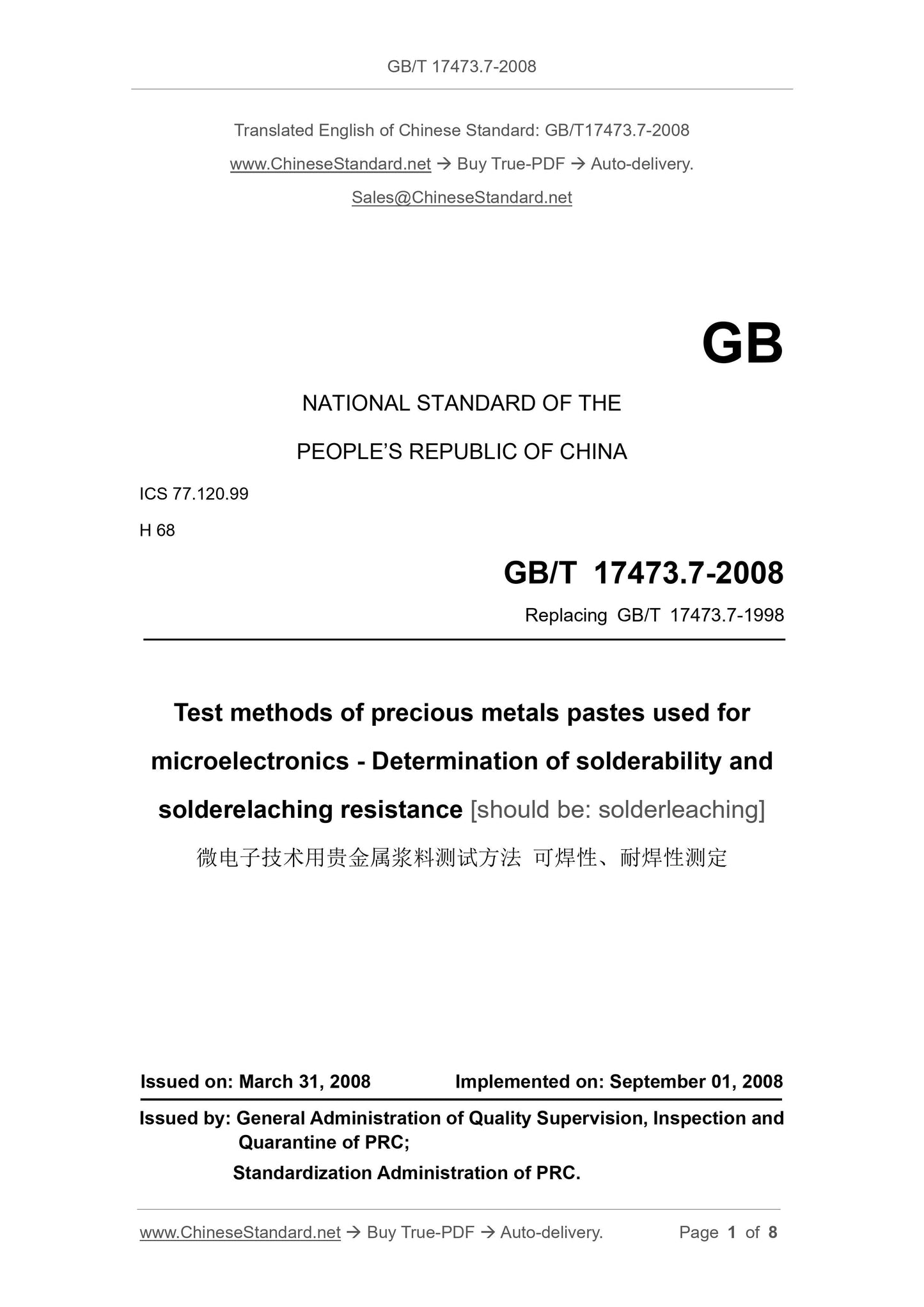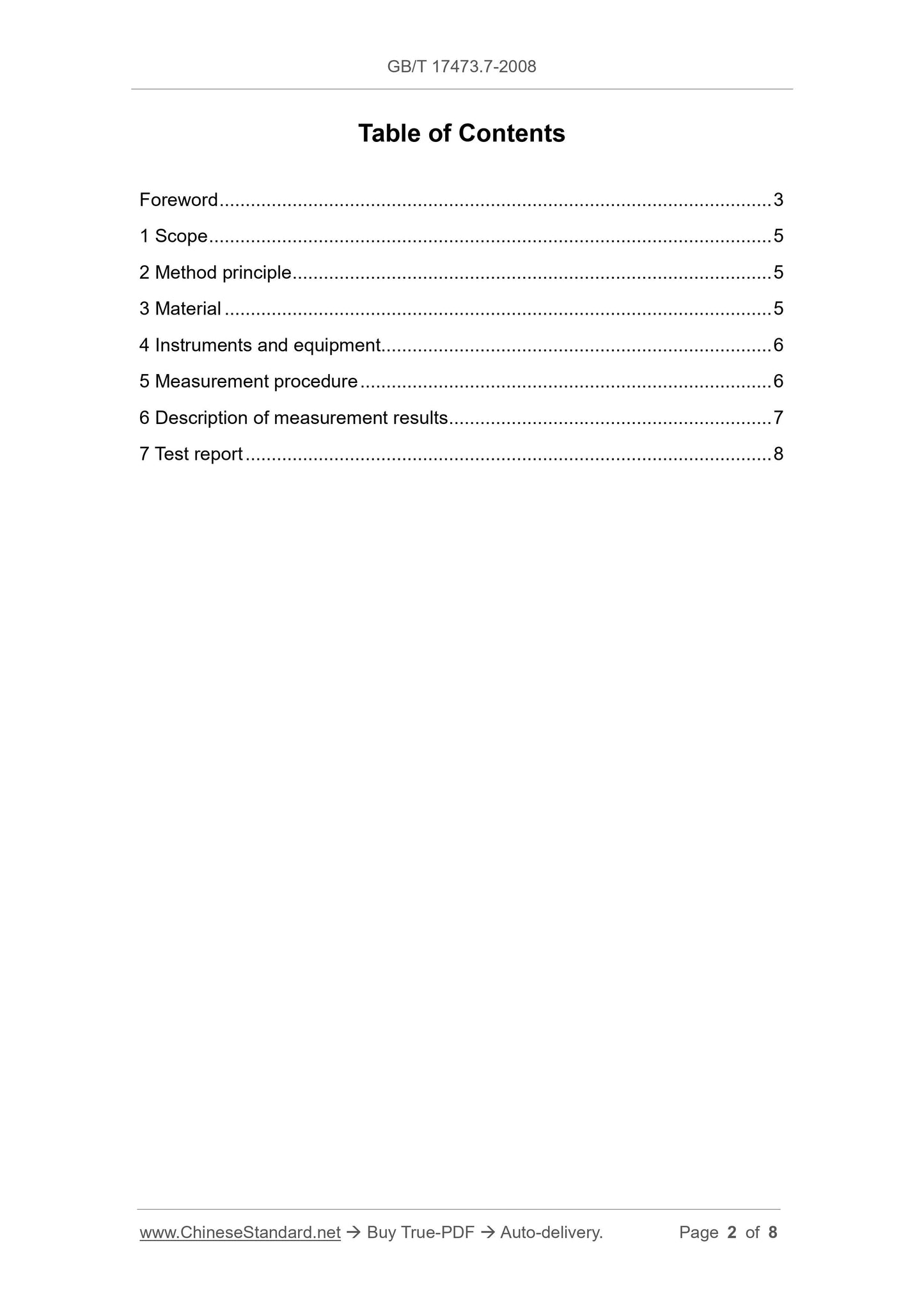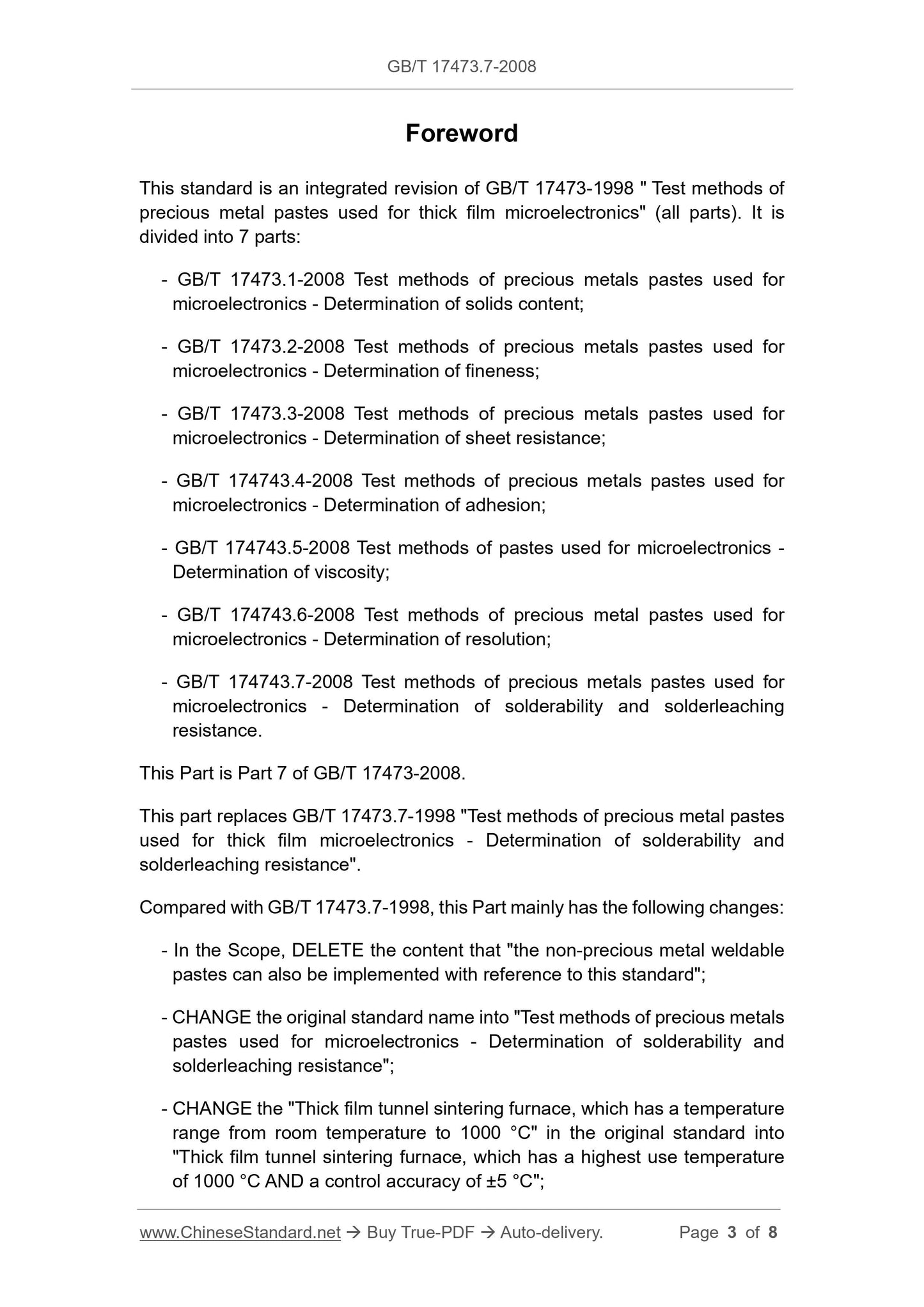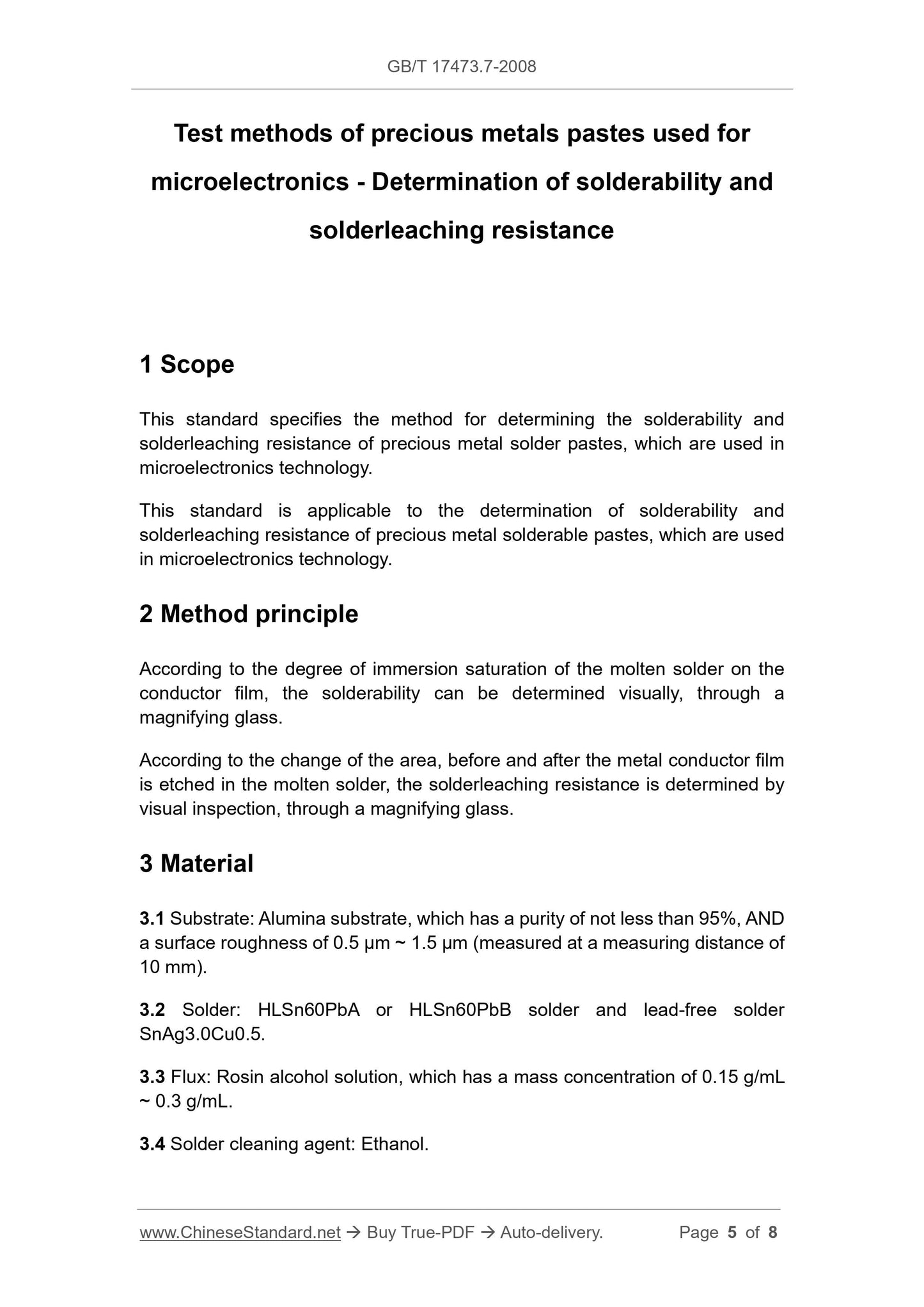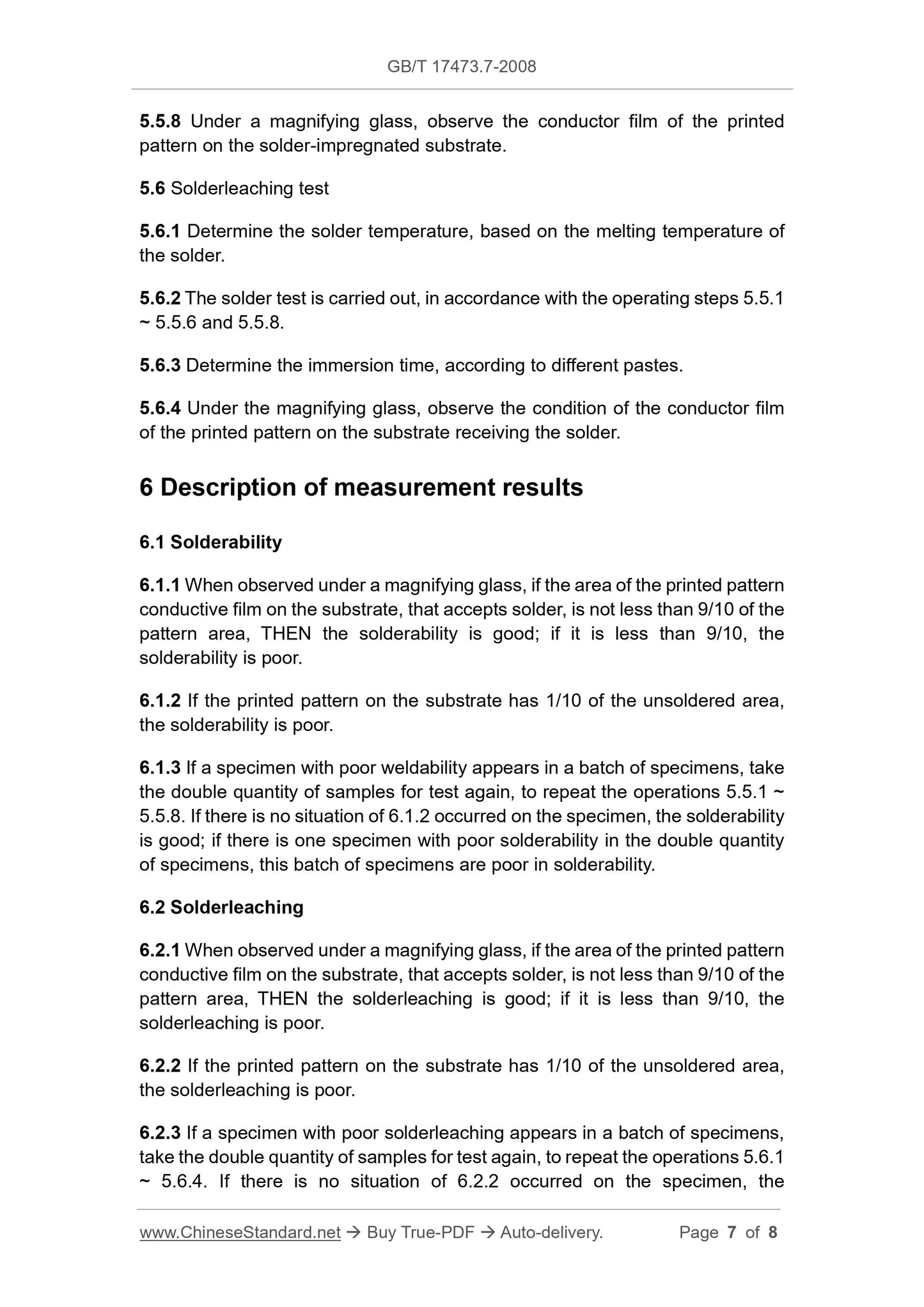1
/
of
5
www.ChineseStandard.us -- Field Test Asia Pte. Ltd.
GB/T 17473.7-2008 English PDF (GB/T17473.7-2008)
GB/T 17473.7-2008 English PDF (GB/T17473.7-2008)
Regular price
$70.00
Regular price
Sale price
$70.00
Unit price
/
per
Shipping calculated at checkout.
Couldn't load pickup availability
GB/T 17473.7-2008: Test methods of precious metals pastes used for microelectronics -- Determination of solderability and solderelaching resistance
Delivery: 9 seconds. Download (& Email) true-PDF + Invoice.
Get Quotation: Click GB/T 17473.7-2008 (Self-service in 1-minute)
Historical versions (Master-website): GB/T 17473.7-2008
Preview True-PDF (Reload/Scroll-down if blank)
GB/T 17473.7-2008
GB
NATIONAL STANDARD OF THE
PEOPLE’S REPUBLIC OF CHINA
ICS 77.120.99
H 68
Replacing GB/T 17473.7-1998
Test methods of precious metals pastes used for
microelectronics - Determination of solderability and
solderelaching resistance [should be: solderleaching]
ISSUED ON: MARCH 31, 2008
IMPLEMENTED ON: SEPTEMBER 01, 2008
Issued by: General Administration of Quality Supervision, Inspection and
Quarantine of PRC;
Standardization Administration of PRC.
Table of Contents
Foreword ... 3
1 Scope ... 5
2 Method principle ... 5
3 Material ... 5
4 Instruments and equipment... 6
5 Measurement procedure ... 6
6 Description of measurement results ... 7
7 Test report ... 8
Foreword
This standard is an integrated revision of GB/T 17473-1998 " Test methods of
precious metal pastes used for thick film microelectronics" (all parts). It is
divided into 7 parts:
- GB/T 17473.1-2008 Test methods of precious metals pastes used for
microelectronics - Determination of solids content;
- GB/T 17473.2-2008 Test methods of precious metals pastes used for
microelectronics - Determination of fineness;
- GB/T 17473.3-2008 Test methods of precious metals pastes used for
microelectronics - Determination of sheet resistance;
- GB/T 174743.4-2008 Test methods of precious metals pastes used for
microelectronics - Determination of adhesion;
- GB/T 174743.5-2008 Test methods of pastes used for microelectronics -
Determination of viscosity;
- GB/T 174743.6-2008 Test methods of precious metal pastes used for
microelectronics - Determination of resolution;
- GB/T 174743.7-2008 Test methods of precious metals pastes used for
microelectronics - Determination of solderability and solderleaching
resistance.
This Part is Part 7 of GB/T 17473-2008.
This part replaces GB/T 17473.7-1998 "Test methods of precious metal pastes
used for thick film microelectronics - Determination of solderability and
solderleaching resistance".
Compared with GB/T 17473.7-1998, this Part mainly has the following changes:
- In the Scope, DELETE the content that "the non-precious metal weldable
pastes can also be implemented with reference to this standard";
- CHANGE the original standard name into "Test methods of precious metals
pastes used for microelectronics - Determination of solderability and
solderleaching resistance";
- CHANGE the "Thick film tunnel sintering furnace, which has a temperature
range from room temperature to 1000 °C" in the original standard into
"Thick film tunnel sintering furnace, which has a highest use temperature
of 1000 °C AND a control accuracy of ±5 °C";
Test methods of precious metals pastes used for
microelectronics - Determination of solderability and
solderleaching resistance
1 Scope
This standard specifies the method for determining the solderability and
solderleaching resistance of precious metal solder pastes, which are used in
microelectronics technology.
This standard is applicable to the determination of solderability and
solderleaching resistance of precious metal solderable pastes, which are used
in microelectronics technology.
2 Method principle
According to the degree of immersion saturation of the molten solder on the
conductor film, the solderability can be determined visually, through a
magnifying glass.
According to the change of the area, before and after the metal conductor film
is etched in the molten solder, the solderleaching resistance is determined by
visual inspection, through a magnifying glass.
3 Material
3.1 Substrate: Alumina substrate, which has a purity of not less than 95%, AND
a surface roughness of 0.5 μm ~ 1.5 μm (measured at a measuring distance of
10 mm).
3.2 Solder: HLSn60PbA or HLSn60PbB solder and lead-free solder
SnAg3.0Cu0.5.
3.3 Flux: Rosin alcohol solution, which has a mass concentration of 0.15 g/mL
~ 0.3 g/mL.
3.4 Solder cleaning agent: Ethanol.
5.5.8 Under a magnifying glass, observe the conductor film of the printed
pattern on the solder-impregnated substrate.
5.6 Solderleaching test
5.6.1 Determine the solder temperature, based on the melting temperature of
the solder.
5.6.2 The solder test is carried out, in accordance with the operating steps 5.5.1
~ 5.5.6 and 5.5.8.
5.6.3 Determine the immersion time, according to different pastes.
5.6.4 Under the magnifying glass, observe the condition of the conductor film
of the printed pattern on the substrate receiving the solder.
6 Description of measurement results
6.1 Solderability
6.1.1 When observed under a magnifying glass, if the area of the printed pattern
conductive film on the substrate, that accepts solder, is not less than 9/10 of the
pattern area, THEN the solderability is good; if it is less than 9/10, the
solderability is poor.
6.1.2 If the printed pattern on the substrate has 1/10 of the unsoldered area,
the solderability is poor.
6.1.3 If a specimen with poor weldability appears in a batch of specimens, take
the double quantity of samples for test again, to repeat the operations 5.5.1 ~
5.5.8. If there is no situation of 6.1.2 occurred on the specimen, the solderability
is good; if there is one specimen with poor solderability in the double quantity
of specimens, this batch of specimens are poor in solderability.
6.2 Solderleaching
6.2.1 When observed under a magnifying glass, if the area of the printed pattern
conductive film on the substrate, that accepts solder, is not less than 9/10 of the
pattern area, THEN the solderleaching is good; if it is less than 9/10, the
solderleaching is poor.
6.2.2 If the printed pattern on the substrate has 1/10 of the unsoldered area,
the solderleaching is poor.
6.2.3 If a specimen with poor solderleaching appears in a batch of specimens,
take the double quantity of samples for test again, to repeat the operations 5.6.1
~ 5.6.4. If there is no situation of 6.2.2 occurred on the specimen, the
GB/T 17473.7-2008
GB
NATIONAL STANDARD OF THE
PEOPLE’S REPUBLIC OF CHINA
ICS 77.120.99
H 68
Replacing GB/T 17473.7-1998
Test methods of precious metals pastes used for
microelectronics - Determination of solderability and
solderelaching resistance [should be: solderleaching]
ISSUED ON: MARCH 31, 2008
IMPLEMENTED ON: SEPTEMBER 01, 2008
Issued by: General Administration of Quality Supervision, Inspection and
Quarantine of PRC;
Standardization Administration of PRC.
Table of Contents
Foreword ... 3
1 Scope ... 5
2 Method principle ... 5
3 Material ... 5
4 Instruments and equipment... 6
5 Measurement procedure ... 6
6 Description of measurement results ... 7
7 Test report ... 8
Foreword
This standard is an integrated revision of GB/T 17473-1998 " Test methods of
precious metal pastes used for thick film microelectronics" (all parts). It is
divided into 7 parts:
- GB/T 17473.1-2008 Test methods of precious metals pastes used for
microelectronics - Determination of solids content;
- GB/T 17473.2-2008 Test methods of precious metals pastes used for
microelectronics - Determination of fineness;
- GB/T 17473.3-2008 Test methods of precious metals pastes used for
microelectronics - Determination of sheet resistance;
- GB/T 174743.4-2008 Test methods of precious metals pastes used for
microelectronics - Determination of adhesion;
- GB/T 174743.5-2008 Test methods of pastes used for microelectronics -
Determination of viscosity;
- GB/T 174743.6-2008 Test methods of precious metal pastes used for
microelectronics - Determination of resolution;
- GB/T 174743.7-2008 Test methods of precious metals pastes used for
microelectronics - Determination of solderability and solderleaching
resistance.
This Part is Part 7 of GB/T 17473-2008.
This part replaces GB/T 17473.7-1998 "Test methods of precious metal pastes
used for thick film microelectronics - Determination of solderability and
solderleaching resistance".
Compared with GB/T 17473.7-1998, this Part mainly has the following changes:
- In the Scope, DELETE the content that "the non-precious metal weldable
pastes can also be implemented with reference to this standard";
- CHANGE the original standard name into "Test methods of precious metals
pastes used for microelectronics - Determination of solderability and
solderleaching resistance";
- CHANGE the "Thick film tunnel sintering furnace, which has a temperature
range from room temperature to 1000 °C" in the original standard into
"Thick film tunnel sintering furnace, which has a highest use temperature
of 1000 °C AND a control accuracy of ±5 °C";
Test methods of precious metals pastes used for
microelectronics - Determination of solderability and
solderleaching resistance
1 Scope
This standard specifies the method for determining the solderability and
solderleaching resistance of precious metal solder pastes, which are used in
microelectronics technology.
This standard is applicable to the determination of solderability and
solderleaching resistance of precious metal solderable pastes, which are used
in microelectronics technology.
2 Method principle
According to the degree of immersion saturation of the molten solder on the
conductor film, the solderability can be determined visually, through a
magnifying glass.
According to the change of the area, before and after the metal conductor film
is etched in the molten solder, the solderleaching resistance is determined by
visual inspection, through a magnifying glass.
3 Material
3.1 Substrate: Alumina substrate, which has a purity of not less than 95%, AND
a surface roughness of 0.5 μm ~ 1.5 μm (measured at a measuring distance of
10 mm).
3.2 Solder: HLSn60PbA or HLSn60PbB solder and lead-free solder
SnAg3.0Cu0.5.
3.3 Flux: Rosin alcohol solution, which has a mass concentration of 0.15 g/mL
~ 0.3 g/mL.
3.4 Solder cleaning agent: Ethanol.
5.5.8 Under a magnifying glass, observe the conductor film of the printed
pattern on the solder-impregnated substrate.
5.6 Solderleaching test
5.6.1 Determine the solder temperature, based on the melting temperature of
the solder.
5.6.2 The solder test is carried out, in accordance with the operating steps 5.5.1
~ 5.5.6 and 5.5.8.
5.6.3 Determine the immersion time, according to different pastes.
5.6.4 Under the magnifying glass, observe the condition of the conductor film
of the printed pattern on the substrate receiving the solder.
6 Description of measurement results
6.1 Solderability
6.1.1 When observed under a magnifying glass, if the area of the printed pattern
conductive film on the substrate, that accepts solder, is not less than 9/10 of the
pattern area, THEN the solderability is good; if it is less than 9/10, the
solderability is poor.
6.1.2 If the printed pattern on the substrate has 1/10 of the unsoldered area,
the solderability is poor.
6.1.3 If a specimen with poor weldability appears in a batch of specimens, take
the double quantity of samples for test again, to repeat the operations 5.5.1 ~
5.5.8. If there is no situation of 6.1.2 occurred on the specimen, the solderability
is good; if there is one specimen with poor solderability in the double quantity
of specimens, this batch of specimens are poor in solderability.
6.2 Solderleaching
6.2.1 When observed under a magnifying glass, if the area of the printed pattern
conductive film on the substrate, that accepts solder, is not less than 9/10 of the
pattern area, THEN the solderleaching is good; if it is less than 9/10, the
solderleaching is poor.
6.2.2 If the printed pattern on the substrate has 1/10 of the unsoldered area,
the solderleaching is poor.
6.2.3 If a specimen with poor solderleaching appears in a batch of specimens,
take the double quantity of samples for test again, to repeat the operations 5.6.1
~ 5.6.4. If there is no situation of 6.2.2 occurred on the specimen, the
Delivery: 9 seconds. Download (& Email) true-PDF + Invoice.
Get Quotation: Click GB/T 17473.7-2008 (Self-service in 1-minute)
Historical versions (Master-website): GB/T 17473.7-2008
Preview True-PDF (Reload/Scroll-down if blank)
GB/T 17473.7-2008
GB
NATIONAL STANDARD OF THE
PEOPLE’S REPUBLIC OF CHINA
ICS 77.120.99
H 68
Replacing GB/T 17473.7-1998
Test methods of precious metals pastes used for
microelectronics - Determination of solderability and
solderelaching resistance [should be: solderleaching]
ISSUED ON: MARCH 31, 2008
IMPLEMENTED ON: SEPTEMBER 01, 2008
Issued by: General Administration of Quality Supervision, Inspection and
Quarantine of PRC;
Standardization Administration of PRC.
Table of Contents
Foreword ... 3
1 Scope ... 5
2 Method principle ... 5
3 Material ... 5
4 Instruments and equipment... 6
5 Measurement procedure ... 6
6 Description of measurement results ... 7
7 Test report ... 8
Foreword
This standard is an integrated revision of GB/T 17473-1998 " Test methods of
precious metal pastes used for thick film microelectronics" (all parts). It is
divided into 7 parts:
- GB/T 17473.1-2008 Test methods of precious metals pastes used for
microelectronics - Determination of solids content;
- GB/T 17473.2-2008 Test methods of precious metals pastes used for
microelectronics - Determination of fineness;
- GB/T 17473.3-2008 Test methods of precious metals pastes used for
microelectronics - Determination of sheet resistance;
- GB/T 174743.4-2008 Test methods of precious metals pastes used for
microelectronics - Determination of adhesion;
- GB/T 174743.5-2008 Test methods of pastes used for microelectronics -
Determination of viscosity;
- GB/T 174743.6-2008 Test methods of precious metal pastes used for
microelectronics - Determination of resolution;
- GB/T 174743.7-2008 Test methods of precious metals pastes used for
microelectronics - Determination of solderability and solderleaching
resistance.
This Part is Part 7 of GB/T 17473-2008.
This part replaces GB/T 17473.7-1998 "Test methods of precious metal pastes
used for thick film microelectronics - Determination of solderability and
solderleaching resistance".
Compared with GB/T 17473.7-1998, this Part mainly has the following changes:
- In the Scope, DELETE the content that "the non-precious metal weldable
pastes can also be implemented with reference to this standard";
- CHANGE the original standard name into "Test methods of precious metals
pastes used for microelectronics - Determination of solderability and
solderleaching resistance";
- CHANGE the "Thick film tunnel sintering furnace, which has a temperature
range from room temperature to 1000 °C" in the original standard into
"Thick film tunnel sintering furnace, which has a highest use temperature
of 1000 °C AND a control accuracy of ±5 °C";
Test methods of precious metals pastes used for
microelectronics - Determination of solderability and
solderleaching resistance
1 Scope
This standard specifies the method for determining the solderability and
solderleaching resistance of precious metal solder pastes, which are used in
microelectronics technology.
This standard is applicable to the determination of solderability and
solderleaching resistance of precious metal solderable pastes, which are used
in microelectronics technology.
2 Method principle
According to the degree of immersion saturation of the molten solder on the
conductor film, the solderability can be determined visually, through a
magnifying glass.
According to the change of the area, before and after the metal conductor film
is etched in the molten solder, the solderleaching resistance is determined by
visual inspection, through a magnifying glass.
3 Material
3.1 Substrate: Alumina substrate, which has a purity of not less than 95%, AND
a surface roughness of 0.5 μm ~ 1.5 μm (measured at a measuring distance of
10 mm).
3.2 Solder: HLSn60PbA or HLSn60PbB solder and lead-free solder
SnAg3.0Cu0.5.
3.3 Flux: Rosin alcohol solution, which has a mass concentration of 0.15 g/mL
~ 0.3 g/mL.
3.4 Solder cleaning agent: Ethanol.
5.5.8 Under a magnifying glass, observe the conductor film of the printed
pattern on the solder-impregnated substrate.
5.6 Solderleaching test
5.6.1 Determine the solder temperature, based on the melting temperature of
the solder.
5.6.2 The solder test is carried out, in accordance with the operating steps 5.5.1
~ 5.5.6 and 5.5.8.
5.6.3 Determine the immersion time, according to different pastes.
5.6.4 Under the magnifying glass, observe the condition of the conductor film
of the printed pattern on the substrate receiving the solder.
6 Description of measurement results
6.1 Solderability
6.1.1 When observed under a magnifying glass, if the area of the printed pattern
conductive film on the substrate, that accepts solder, is not less than 9/10 of the
pattern area, THEN the solderability is good; if it is less than 9/10, the
solderability is poor.
6.1.2 If the printed pattern on the substrate has 1/10 of the unsoldered area,
the solderability is poor.
6.1.3 If a specimen with poor weldability appears in a batch of specimens, take
the double quantity of samples for test again, to repeat the operations 5.5.1 ~
5.5.8. If there is no situation of 6.1.2 occurred on the specimen, the solderability
is good; if there is one specimen with poor solderability in the double quantity
of specimens, this batch of specimens are poor in solderability.
6.2 Solderleaching
6.2.1 When observed under a magnifying glass, if the area of the printed pattern
conductive film on the substrate, that accepts solder, is not less than 9/10 of the
pattern area, THEN the solderleaching is good; if it is less than 9/10, the
solderleaching is poor.
6.2.2 If the printed pattern on the substrate has 1/10 of the unsoldered area,
the solderleaching is poor.
6.2.3 If a specimen with poor solderleaching appears in a batch of specimens,
take the double quantity of samples for test again, to repeat the operations 5.6.1
~ 5.6.4. If there is no situation of 6.2.2 occurred on the specimen, the
GB/T 17473.7-2008
GB
NATIONAL STANDARD OF THE
PEOPLE’S REPUBLIC OF CHINA
ICS 77.120.99
H 68
Replacing GB/T 17473.7-1998
Test methods of precious metals pastes used for
microelectronics - Determination of solderability and
solderelaching resistance [should be: solderleaching]
ISSUED ON: MARCH 31, 2008
IMPLEMENTED ON: SEPTEMBER 01, 2008
Issued by: General Administration of Quality Supervision, Inspection and
Quarantine of PRC;
Standardization Administration of PRC.
Table of Contents
Foreword ... 3
1 Scope ... 5
2 Method principle ... 5
3 Material ... 5
4 Instruments and equipment... 6
5 Measurement procedure ... 6
6 Description of measurement results ... 7
7 Test report ... 8
Foreword
This standard is an integrated revision of GB/T 17473-1998 " Test methods of
precious metal pastes used for thick film microelectronics" (all parts). It is
divided into 7 parts:
- GB/T 17473.1-2008 Test methods of precious metals pastes used for
microelectronics - Determination of solids content;
- GB/T 17473.2-2008 Test methods of precious metals pastes used for
microelectronics - Determination of fineness;
- GB/T 17473.3-2008 Test methods of precious metals pastes used for
microelectronics - Determination of sheet resistance;
- GB/T 174743.4-2008 Test methods of precious metals pastes used for
microelectronics - Determination of adhesion;
- GB/T 174743.5-2008 Test methods of pastes used for microelectronics -
Determination of viscosity;
- GB/T 174743.6-2008 Test methods of precious metal pastes used for
microelectronics - Determination of resolution;
- GB/T 174743.7-2008 Test methods of precious metals pastes used for
microelectronics - Determination of solderability and solderleaching
resistance.
This Part is Part 7 of GB/T 17473-2008.
This part replaces GB/T 17473.7-1998 "Test methods of precious metal pastes
used for thick film microelectronics - Determination of solderability and
solderleaching resistance".
Compared with GB/T 17473.7-1998, this Part mainly has the following changes:
- In the Scope, DELETE the content that "the non-precious metal weldable
pastes can also be implemented with reference to this standard";
- CHANGE the original standard name into "Test methods of precious metals
pastes used for microelectronics - Determination of solderability and
solderleaching resistance";
- CHANGE the "Thick film tunnel sintering furnace, which has a temperature
range from room temperature to 1000 °C" in the original standard into
"Thick film tunnel sintering furnace, which has a highest use temperature
of 1000 °C AND a control accuracy of ±5 °C";
Test methods of precious metals pastes used for
microelectronics - Determination of solderability and
solderleaching resistance
1 Scope
This standard specifies the method for determining the solderability and
solderleaching resistance of precious metal solder pastes, which are used in
microelectronics technology.
This standard is applicable to the determination of solderability and
solderleaching resistance of precious metal solderable pastes, which are used
in microelectronics technology.
2 Method principle
According to the degree of immersion saturation of the molten solder on the
conductor film, the solderability can be determined visually, through a
magnifying glass.
According to the change of the area, before and after the metal conductor film
is etched in the molten solder, the solderleaching resistance is determined by
visual inspection, through a magnifying glass.
3 Material
3.1 Substrate: Alumina substrate, which has a purity of not less than 95%, AND
a surface roughness of 0.5 μm ~ 1.5 μm (measured at a measuring distance of
10 mm).
3.2 Solder: HLSn60PbA or HLSn60PbB solder and lead-free solder
SnAg3.0Cu0.5.
3.3 Flux: Rosin alcohol solution, which has a mass concentration of 0.15 g/mL
~ 0.3 g/mL.
3.4 Solder cleaning agent: Ethanol.
5.5.8 Under a magnifying glass, observe the conductor film of the printed
pattern on the solder-impregnated substrate.
5.6 Solderleaching test
5.6.1 Determine the solder temperature, based on the melting temperature of
the solder.
5.6.2 The solder test is carried out, in accordance with the operating steps 5.5.1
~ 5.5.6 and 5.5.8.
5.6.3 Determine the immersion time, according to different pastes.
5.6.4 Under the magnifying glass, observe the condition of the conductor film
of the printed pattern on the substrate receiving the solder.
6 Description of measurement results
6.1 Solderability
6.1.1 When observed under a magnifying glass, if the area of the printed pattern
conductive film on the substrate, that accepts solder, is not less than 9/10 of the
pattern area, THEN the solderability is good; if it is less than 9/10, the
solderability is poor.
6.1.2 If the printed pattern on the substrate has 1/10 of the unsoldered area,
the solderability is poor.
6.1.3 If a specimen with poor weldability appears in a batch of specimens, take
the double quantity of samples for test again, to repeat the operations 5.5.1 ~
5.5.8. If there is no situation of 6.1.2 occurred on the specimen, the solderability
is good; if there is one specimen with poor solderability in the double quantity
of specimens, this batch of specimens are poor in solderability.
6.2 Solderleaching
6.2.1 When observed under a magnifying glass, if the area of the printed pattern
conductive film on the substrate, that accepts solder, is not less than 9/10 of the
pattern area, THEN the solderleaching is good; if it is less than 9/10, the
solderleaching is poor.
6.2.2 If the printed pattern on the substrate has 1/10 of the unsoldered area,
the solderleaching is poor.
6.2.3 If a specimen with poor solderleaching appears in a batch of specimens,
take the double quantity of samples for test again, to repeat the operations 5.6.1
~ 5.6.4. If there is no situation of 6.2.2 occurred on the specimen, the
Share
